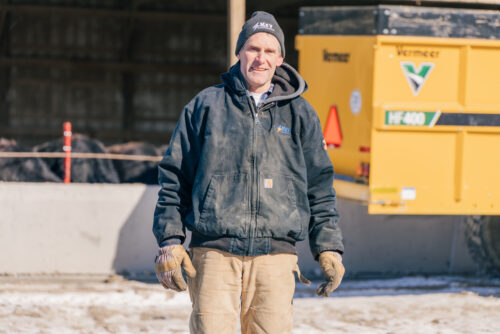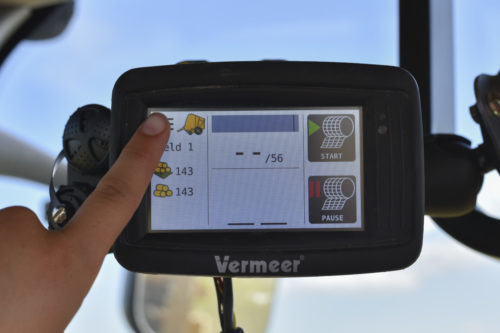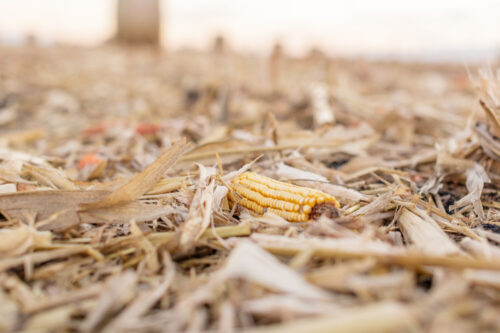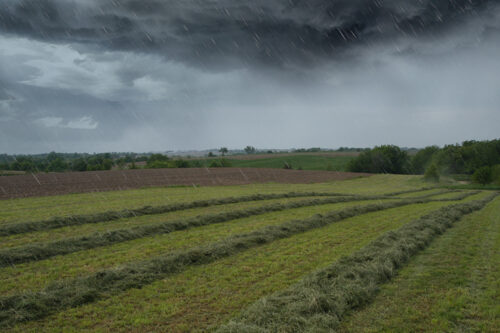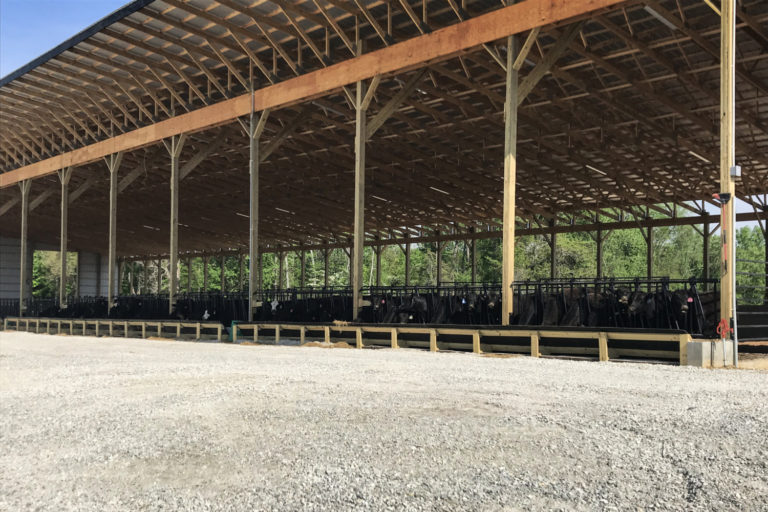
Cattleman Boosts Animal Husbandry, Feed Efficiency with Indoor Cow/calf Facility
July 2018
Kyle Lyon’s initial interest in raising cattle indoors was stoked after a chance meeting at a farm show a couple of years ago, and he’s put that interest into action by constructing a building that has quickly shown considerable benefits in managing his cow/calf operation near Madison, Indiana.
At the 2017 National Farm Machinery Show in Louisville, Kentucky, Lyon spoke with an exhibitor promoting the construction of hoop buildings for housing cattle. He did his homework and found a similar facility would fit his own operation.
“I spent the whole day talking to him, and the more I talked to him, the more interested I got,” Lyon said. “He was just down the road from me in Kentucky, so I went and visited his operation, then got even more interested. I visited probably 10 more operations where people were managing similar operations to see if it would work on my farm, then decided to pull the trigger myself.”
How it works
Raising cattle indoors is not a new concept, though interest is rebounding among producers for several reasons. Increasing land prices and the opportunity to better control and manage cattle – whether it’s simply feed rations or better care for calving cows – are causing more producers to look to indoor systems where the circumstances are right. Utilizing a barn, monoslope or hoop building with deep bedding (sawdust and cornstalks are the most common bedding materials) and controlled feeding systems can help minimize the environmental stress the animals experience outside and improve producer productivity by boosting feed efficiency and decreasing the number of days required to be on feed before reaching processing weight.
“There’s growing interest because producers can use cropland in double duty for grain and forage, or use locally available, economical feeds like crop residues and industry byproducts,” according to Purdue University Animal Sciences, Ruminant Nutrition and Beef Management Specialist Ron Lemenager.
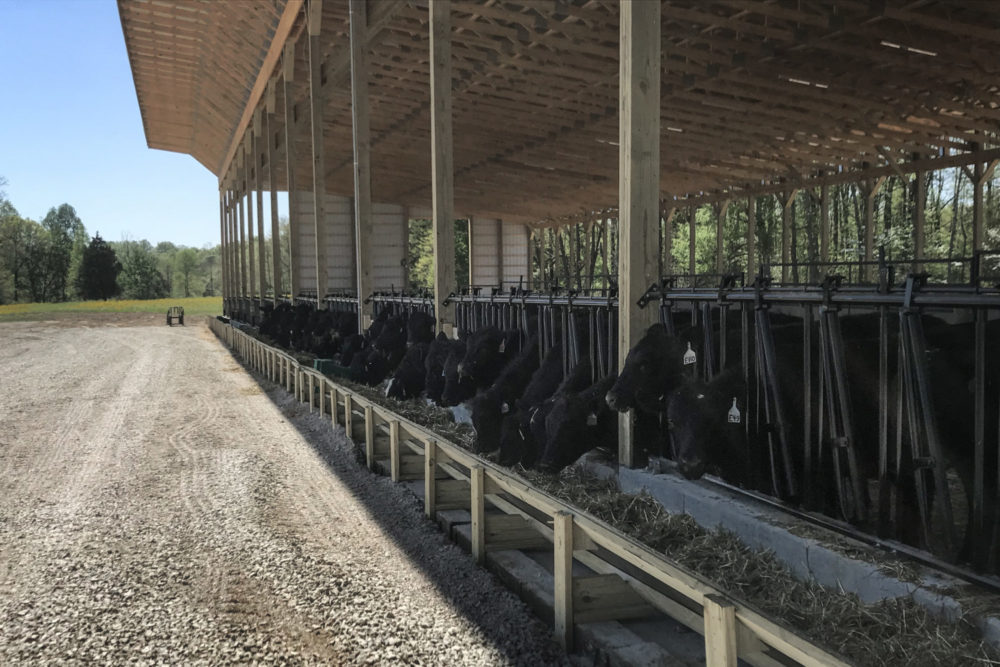
Shelter, ventilation and feed availability are all key components of a successful indoor cattle facility.
“Deep-bedded facilities typically are totally roofed confinement structures with partial or total solid concrete flooring. Natural ventilation is used in all these facilities. High roofs increase the air space and allow warm, moist air to rise and escape from the building,” according to an Iowa Beef Center report by Iowa State University Extension and Outreach beef and swine field specialist Russ Euken and a team of beef, ag engineering and farm management specialists. “Although in practice, square footage per animal varies greatly in these facilities, a minimum of 40 square feet (3.7 sq m) per head is recommended (up to 90 square feet per animal with cow/calf pairs). Next to the bunk is a concrete bunk apron and the remainder of the floor space is concrete or packed earth covered with crushed limestone or other material to provide a solid base for bedding.”
Successful manure management is also key to the viability of any indoor cattle facility. Though there’s typically more labor involved in doing so, stockpiling manure under shelter and storing it until it can be utilized later typically yields a more consistent nutrient source for cropland application.
“Quantity of manure varies greatly in an open feedlot and is influenced by season,” according to the Iowa Beef Center report. “Confinement buildings retain more nutrients because there is less environmental interaction.”
Lyon’s indoor system
Lyon’s planning reached fruition earlier this year when he finished construction on a 208×60-foot (63.4×18.3 m) monoslope building in which he’s currently housing 100 bred heifers. The animals spend all their time in the building that is open on its ends to provide ample ventilation. Feed and water are readily available, minimizing stress on the animals that would otherwise be common when grazing in open pasture.
Lyon’s building has a solid sloping roof and is open on the north and south ends with metal walls on the east and west sides, allowing for full ventilation. He uses a sawdust mixture for bedding throughout the building with the exception of a concrete alley adjoining the feed bunks.
“The main selling point to me was being able to just take better care of your cattle. You can control their rations and give them exactly what they need, whether they’re gestating or open. That was probably the biggest benefit I saw,” Lyon said. “Our winters can be rough on the cattle when they’re outside in the mud. In the barns, they’re staying clean and dry and have feed and clean, fresh water right by them all the time. You can keep a closer eye on the cattle.”
Lyon scrapes manure from the concrete alley about once a week, moving it out to an adjoining barn for storage and utilization later on as crop fertilizer.
“The value of the manure is almost equal to the payments on the building. I didn’t know before that manure is so inconsistent with cows on pasture. In this system, it is consistent all the way through,” Lyon said. “When I scrape the concrete alley, I keep it covered and it will stay in that adjoining building until it gets applied to my fields.”

Labor and cost benefits
While it is a more hands-on system and requires more management than feeding cows on pasture, Lyon said morning feeding typically takes around 30 to 45 minutes. Because he’s better able to keep a close eye on his cattle indoors, he does anticipate saving time when it comes to treating animals when necessary, though he expects the likelihood of animal health issues may be lower because of his ability to better control his animals’ feed intake
“Out on the grass, you don’t know what exactly they’re getting. You throw some mineral out to supplement the grass, but you don’t know if they’re all going to go to the bunk,” Lyon said. “Sure, if they’re out on pasture, you’re not messing with them every day, but the animals are not having to work as hard as when they’re on grass. In this building, they’re living the life of a retiree!”
Lyon did incur costs to construct his cattle building, and there are continuous costs to maintain it. But, he’s already seen savings from the system. Feed is always the greatest expense in maintaining a livestock herd, and he sees a direct cost benefit on his feed bills because of the facility. Right now, he’s seeing around a 25-percent savings in feed volume alone.
“We always figure about two acres to support each cow in this part of the country if you take care of your pasture,” said Lyon, who operates a Vermeer 504 Pro baler for his baled forage. “With this building, I can feed each one the equivalent of about three quarters of an acre because I can utilize corn silage, cover crops and summer annuals.”
Lyon has long fed his cattle corn silage, and his Vermeer 504 Pro baler helps him harvest the forage consistently, which ultimately leads to a more uniform feed ration that yields similarly invariable weight gain in his cattle. With a combination of a more consistent silage supply and the relative ease of conditions for the heifers he is raising and feeding indoors, he said he’s been able to back off his ration slightly so now he’s feeding around 2/3 silage and 1/3 oat hay. Based on information from his nutritionist, that ration is helping his heifers feed and gain weight more efficiently.
“My nutritionist said those cows should clean up the bunks in eight to 12 hours. Right now, they’re eating about 75 percent of what we were feeding outdoors and still gaining what they should, and it’s still taking them about 12 hours to clean the bunks. They’re getting what they need,” Lyon said.
They just don’t have to work for it as much. They’re walking to water, feed and laying down. They’re not climbing around in the pasture and in the mud working for things.”
Future growth potential
Looking ahead to breeding and calving, Lyon said there remain some questions on how well it will work in his facility, but he has confidence that his specific 100 heifers will perform well as a group.
“I’ve got them all in there together. They’re not penned off. I think as long as they’re similar sizes or ages, they’re going to run together okay,” he said. “I’m sure I’ll have one here and there that I’ll have to give a little extra attention to, but others have calved around the same number together with no problems.”
Indoor cattle facilities like Lyon’s are indeed adjustments producers can make to help expand cow herd numbers and bring additional family members into an operation, according to Lemenager. Lyon agrees; further on down the road, he expects the facility and the benefits to his operation’s productivity will help open new doors to evolve and grow his operation. He recognizes the trade-off in the labor required to maintain his cattle building, but he is up to the challenge as he looks to build upon his first facility in the future.
“I know the guys who build fence and put their cows out on pasture have a good argument that this is more labor-intensive, because in some ways, it is. But, it will help me grow, and I will be expanding it,” he said. “This is cattle country.”
This article contains third-party observations, advice or experiences that do not necessarily reflect the opinions of Vermeer Corporation, its affiliates or its dealers. Testimonials and/or endorsements by customers in specific circumstances may not be representative of normal circumstances experienced by all customers.
Vermeer Corporation reserves the right to make changes in product engineering, design and specifications; add improvements; or discontinue manufacturing or distribution at any time without notice or obligation.


